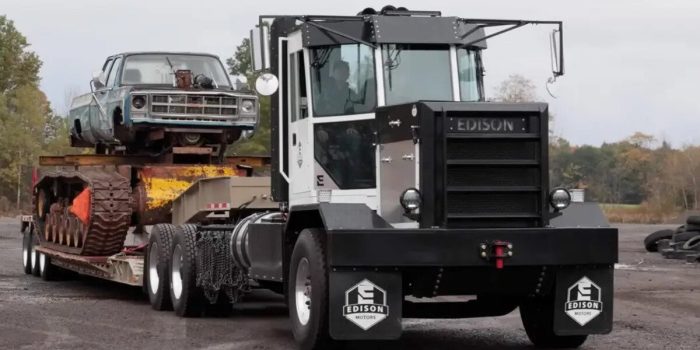Edison, a Canadian company, is shaking up the world of heavy-duty trucks with its innovative approach to electric and hybrid powertrains. For those weary of either traditional diesel big rigs or the hype surrounding electric cars, Edison’s unique creation offers a middle ground that’s gaining attention.
The heart of Edison’s design lies in a distinctive combination of electric and diesel power. While the truck’s wheels are solely driven by electric motors, there’s a 9.3-liter Caterpillar diesel engine under the hood. This diesel engine serves as a generator to keep the truck’s batteries charged and the trailer moving. The result is a truck that can haul an impressive 100,000 pounds with ease, offering a robust and practical solution.
The debate rages online about whether Edison’s creation should be classified as an electric truck or a hybrid, but the company’s founders, Chace Barber and Eric Little, aren’t getting caught up in labels. They have a practical focus on creating a heavy-duty truck that meets the demands of modern transportation needs.

The story of Edison’s inception is intriguing. Barber and Little had initially ordered a Tesla Semi in 2017 but grew tired of waiting for their order to be fulfilled. Instead of continuing to wait, they decided to take matters into their own hands. The result is the Edison L-Series, positioned as the company’s flagship product.
Edison’s L-Series is offered in two variations: the L500 with two drive axles and the L750 with three. Power scales up with each additional axle, starting at 670 horsepower for the base model and reaching 1,005 horsepower for the top-of-the-line version. The Caterpillar engine, functioning as a generator, sends AC power to inverters located behind the truck’s cab. From there, DC power is distributed to the direct-drive motors at each rear axle.

Edison offers two battery options for its trucks: a standard pack with 175 kilowatt-hours of capacity and a larger pack with 280 kilowatt-hours. Regardless of the choice, the truck’s battery receives charges as needed from the generator. This approach ensures a constant fuel consumption rate, even during varying power demands.
Barber and Little’s expertise in powertrain systems has propelled them to the working prototype stage in a remarkably short amount of time, earning respect from trucking industry professionals. Their emphasis on simplicity and serviceability is clear, as they plan to provide a comprehensive parts list for each truck, simplifying maintenance. They use Grade 8 hardware, which can be handled with basic tools, making it easier for truckers to perform repairs when necessary.
Edison’s trucks are designed for various applications, both on highways and off-road, with a particular focus on the logging industry, especially in their native Canada. The company aims to offer twin- and tri-steer options, as well as a power steer e-axle, providing eight-wheel drive capability.
As North America’s infrastructure continues to develop for electric vehicles, Edison’s trucks offer a practical alternative to fully electric semis. In the meantime, the company plans to adapt to the evolving charging infrastructure and offer fully electric trucks when the market is ready. Edison’s innovative approach and commitment to simplicity in design and maintenance position them as a compelling player in the future of heavy-duty trucking.


